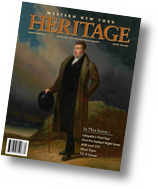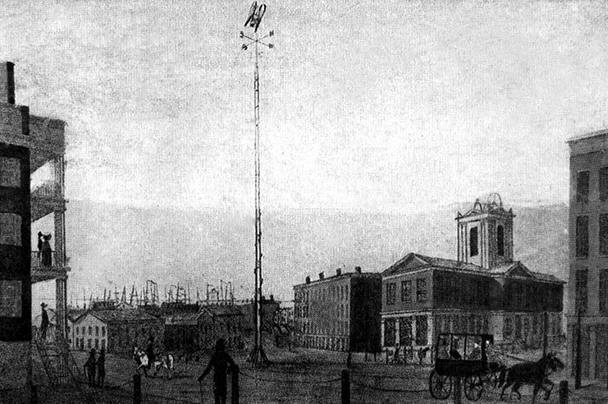
Early sketch of Buffalo's first "Liberty pole" at Main and Terrace. The balconies at left are from the Mansion House; the towered building at right is the Terrace Market. Photo source: Severance, Picture Book of Earlier Buffalo.
The following are excerpts from a Courier-Express article from July 16, 1939 by Robert B. Boltwood entitled, "Razing of Bent Liberty Pole Will Erase Ancient Landmark"
"It was in June, 1838, that the inhabitants of Buffalo assembled to discuss the subject of freedom. Still vivid to them was that night the Market House bell clanged to warn them of the British soldiers near Black Rock. They recalled with horror the burning of the Caroline and they deeply resented being charged with the destruction of the Sir Robert Peet. From such feelings came a unanimous decision to build a Liberty pole. A committee was formed at once.
"Richard Taff, a spar-maker, constructed the mast; Israel McConnell, a ship-joiner, did required joinery; Joel Houston, a blacksmith, provided iron fittings; John Wheedon, a ship carver, carved the eagle; John Carrick, a ship-builder, was master of ceremonies at the dedication and Philip Hemstreet, a house-joiner, collected money to pay for the project.
"Thus...on the Fourth of July [1838] the people of Buffalo clustered around Main Street and The Terrace, a few feet from the site of the first white settler's hut, to dedicate their liberty pole. The wooden mast, braced by beams at the bottom, towered above the surrounding buildings. At the tip was a weather vane and still higher went a rod on which perched John Wheedon's gilded wooden eagle.
"This menacing bird, four feet in height and six feet between wingtips, faced Toronto 'as if he were shrieking defiance to the British lion.' Perhaps it was a reply to a Toronto newspaper editor's call for extermination of the United States.
"Inside the eagle's breast was a copper box containing civic papers and an account of the Liberty pole ceremony..."
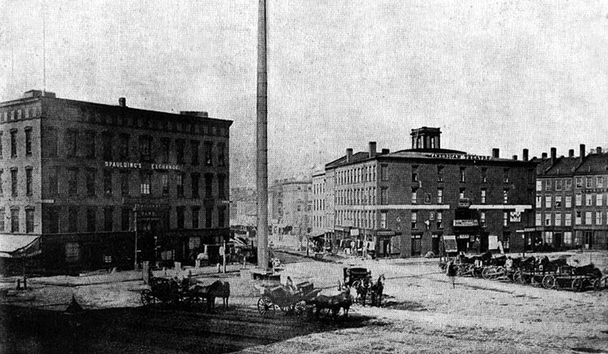
Liberty pole #2, 1866 at the same location as above. At left behind the Liberty pole is the Spaulding Exchange. Image source: Severance, Picture Book of Earlier Buffalo.
"...in 1848 the shaft was shortened to give it greater stability. In June 1860, Levi Waters made a contract with Richard Taff for the construction and erection of a new pole. John Wheedon's weather-beaten eagle was saved, minus some pinions, tail feathers and talons. The copper box showed signs of erosion.
"On July 4, 1860, the Stars and Stripes climbed Buffalo's second Liberty pole amid thundering cheers and strains of the Star Spangled Banner. Newly glued, puttied and painted, the familiar bird perched 125 feet above the crowd and continued to gaze at Toronto. A new copper box combined items of 1860 with those of 1838.
"It was expected the 'huge stick' would last much longer than the first pole, but sixteen years of storms and sunshine played havoc with the wood. On Independence Day, 1877, the residents of Buffalo once more assembled at Main Street and the Terrace to dedicate their third Liberty pole.
"...Richard Taff, builder of the first two shafts, got the contract and constructed a pole 153 feet in length, with a base diameter of 30 inches and a peak diameter of ten inches. The Common Council appropriated $100 for an American flag and cordage and provided for the repair and gilding of Wheedon's wooden eagle. "
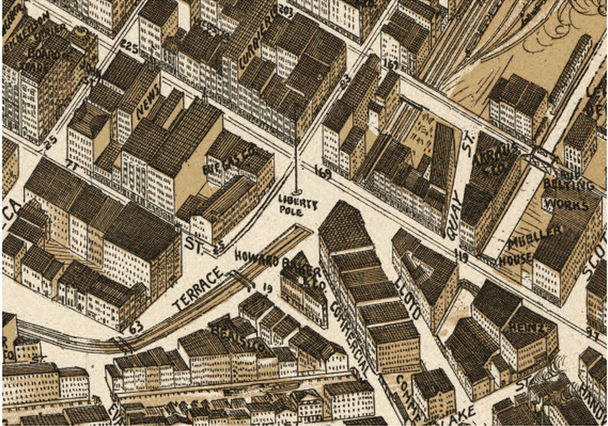
1902 map showing the location of the 4th Liberty pole, 15 feet from the original location of the previous poles.
"In April, 1894, lightning struck this third Liberty pole. For $25, J.P. Kulp and a crew of riggers worked a day and a half to remove the flagstaff, which was rotten in several places....Again, the 56-year old bird was the only object kept intact. The copper box of 1877, now badly rusted, contained a flag so faded that not even the stripes were visible.
"...The patriotism of Buffalo did demand a new Liberty pole. At midnight on June 16, 1894, John P. Learman of the John P. Learman Contracting Company gave his riggers orders to raise a 186-foot tube of boiler steel weighing thirteen tons. By 9 o'clock the next morning the rigging was in order. A huge hoisting engine, using a steel cable and hoisting blocks, reputed the world's strongest, began the herculean task of lifting the fourth and present Liberty pole as persons flocked to Main Street and The Terrace from all directions.
"...For the first time the historic eagle transferred his gaze from Toronto to 'the fair statue of Buffalo that surmounts the monument in Lafayette Square.'"
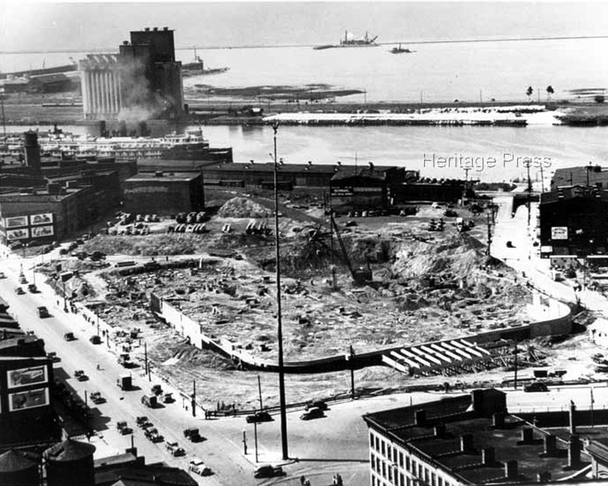
Liberty pole #4, 1939, just before it was demolished. The foundations of the Memorial Auditorium are visible behind the Liberty pole; it was constructed on the side of the Spaulding Exchange. Image source: WNY Heritage.
"One of Buffalo's oldest landmarks soon will be only a memory. The Liberty pole, tallest flagstaff in the world, will disappear from its position at Main Street and The Terrace, where it and three predecessors served to remind a century of Buffalonians of American independence.
"A short time ago a bend appeared in the pole about 60 feet from the base. It was attributed variously to strong winds from the lake, an accident at the time the pole was erected, the real or mythical effect of the sun on the flagstaff, and the weight of the eagle perched on the peak. In any case, a careful investigation proved definitely that rust was making immediate removal of the Liberty pole necessary."
*2006 Note: the wooden eagle did not survive the 4th Liberty pole and began to crumble years before 1939. It was replaced with a metal eagle which was retrieved at the time of demolition in 1939 and is now at the Buffalo & Erie County Historical Society.











